1993 CHEVROLET ASTRO PASSENGER flat tire
[x] Cancel search: flat tirePage 187 of 345
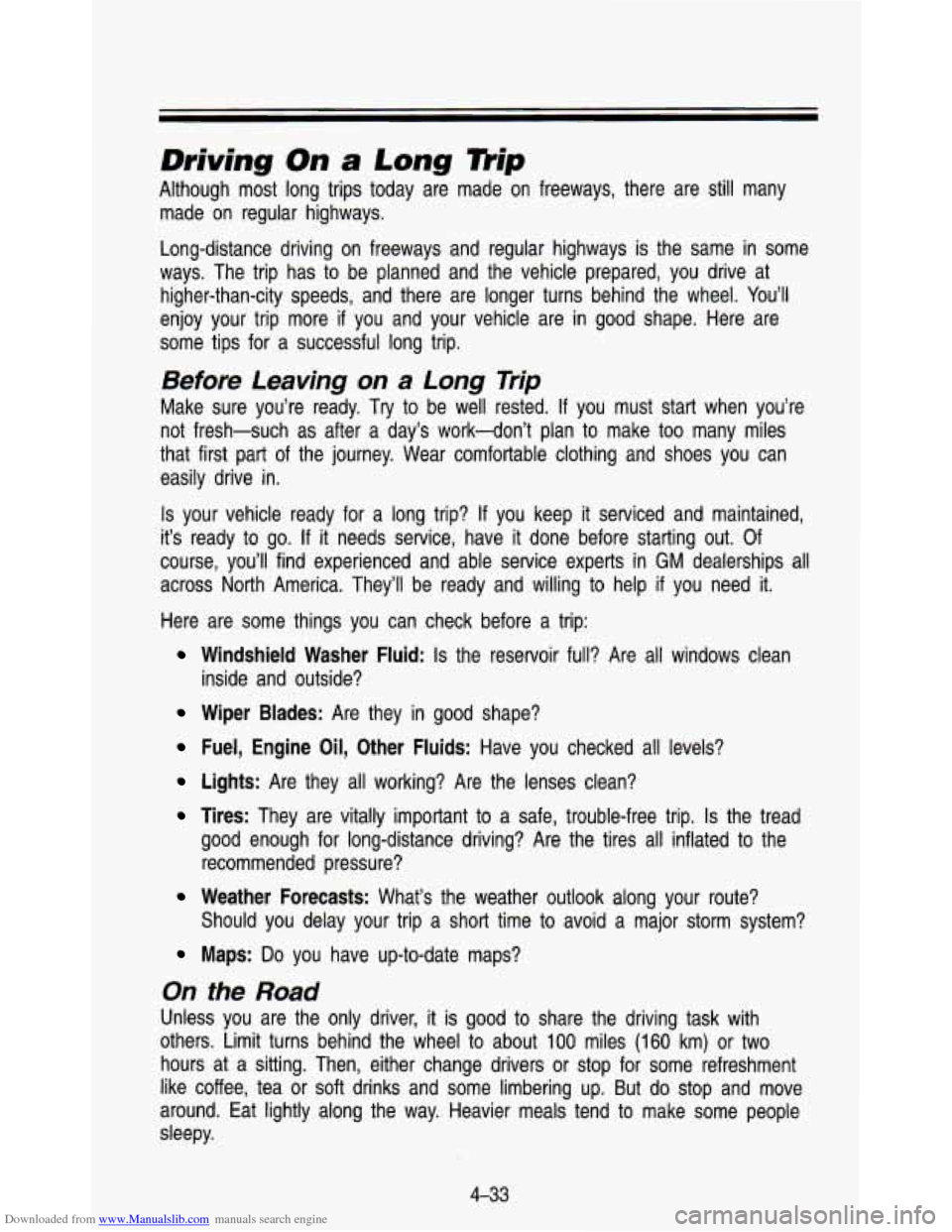
Downloaded from www.Manualslib.com manuals search engine Driving On a Long nip
Although most long trips today are made on freeways, there are still many
made on regular highways.
Long-distance driving on freeways and regular highways is the same in some
ways. The trip has to be planned and the vehicle prepared, you drive at
higher-than-city speeds, and there are longer turns behind the wheel. You’ll
enjoy your trip more
if you and your vehicle are in good shape. Here are
some tips for a successful long trip.
Before Leaving on a Long Trip
Make sure you’re ready. Try to be well rested. If you must start when you’re
not fresh-such as after a day’s work-don’t plan to make too many miles
that first part of the journey. Wear comfortable clothing and shoes you can
easily drive in.
Is your vehicle ready for a long trip? If you keep it serviced and maintained,
it’s ready to
go. If it needs service, have it done before starting out. Of
course, you’ll find experienced and able service experts in
GM dealerships all
across North America. They’ll be ready and willing to help
if you need it.
Here are some things you can check before a trip:
Windshield Washer Fluid: Is the reservoir full? Are all windows clean
Wiper Blades: Are they in good shape?
Fuel, Engine Oil, Other Fluids: Have you checked all levels?
Lights: Are they all working? Are the lenses clean?
Tires: They are vitally important to a safe, trouble-free trip. Is the tread
good enough for long-distance driving? Are the tires all inflated to the
recommended pressure?
Should you delay your trip a short time to avoid a major storm system?
inside and outside?
Weather Forecasts: What’s the weather outlook along your route?
Maps: Do you have up-to-date maps?
On the Road
Unless you
are the only driver, it is good to share the driving task with
others. Limit turns behind the wheel to about
100 miles (160 km) or two
hours- at a sitting. Then, either change drivers or stop for some refres\
hment
like coffee, tea or soft drinks and some limbering up. But
do stop and move
around. Eat lightly along the way. Heavier meals tend to make some people
sleepy.
4-33
Page 189 of 345
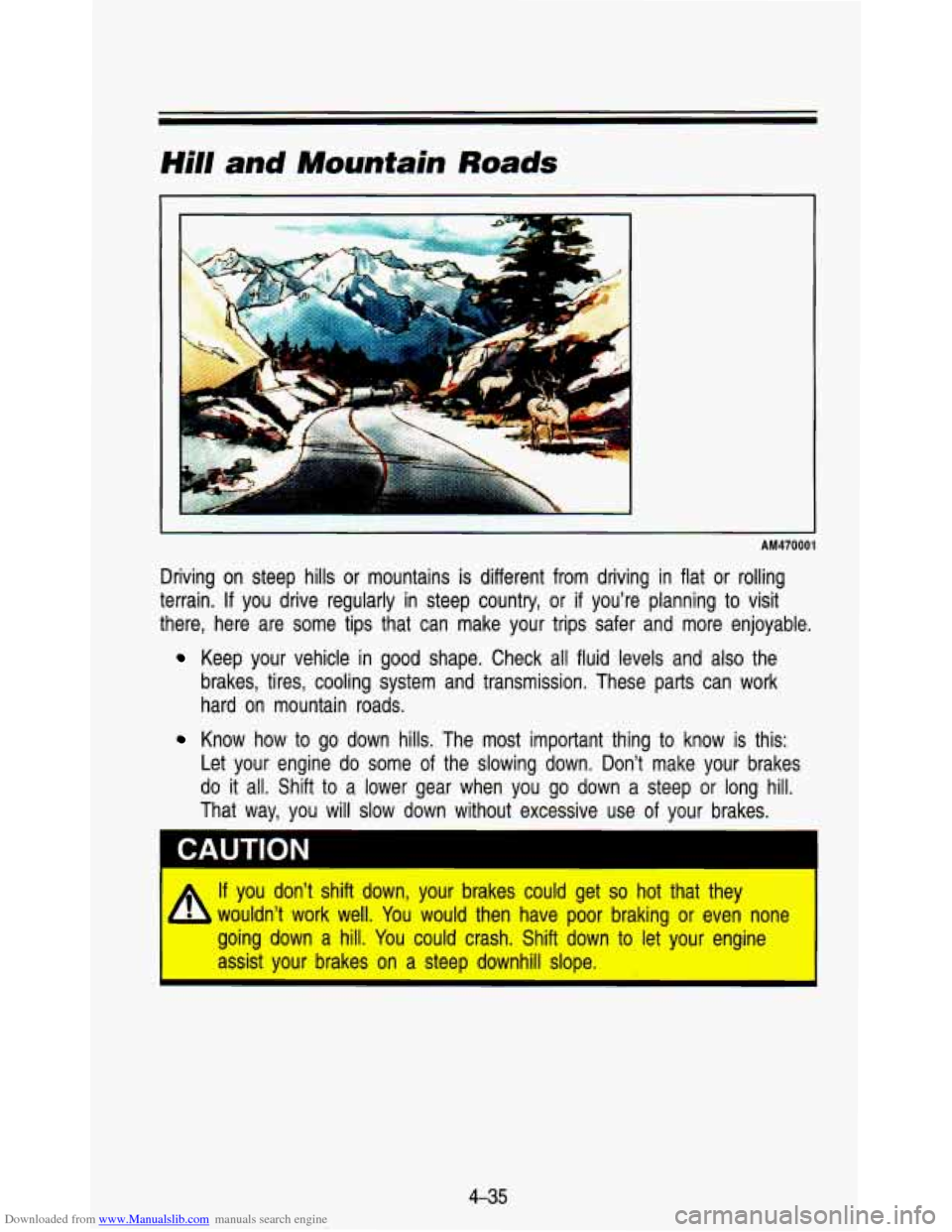
Downloaded from www.Manualslib.com manuals search engine Hill and Mountain Roads
AM470001
Driving on steep hills or mountains is different from driving in flat or rolling
terrain.
If you drive regularly in steep country, or if you're planning to visit
there, here are some tips that can make your trips safer and more enjoyab\
le.
Keep your vehicle in good shape. Check all fluid levels and also the
brakes, tires, cooling system and transmission. These parts can \
work
hard on mountain roads.
Know how to go down hills. The most important thing to know is this:
Let your engine
do some of the slowing down. Don't make your brakes
do it all. Shift
to a lower gear when you go down a steep or long hill.
That way, you will
slow down without excessive use of your brakes.
* If you don't shift down, your brakes could get so hot that they
L b wouldn't work well. You would then have poor braking or even none
going down a hill. You could crash. Shift down to let your engine
assist your brakes on a steep downhill slope.
4-35
Page 199 of 345

Downloaded from www.Manualslib.com manuals search engine Weight of the Trailer Tongue
The tongue load (A) of any trailer is an important weight to measure because it
affects the total or gross weight of your vehicle. The gross vehicle weight (GVW)
includes the curb weight of the vehicle, any cargo you may carry in it, and the
people who will be riding in the vehicle. And
if you will tow a trailer, you must
add the tongue load
to the GVW because your vehicle will be carrying that
weight too. See “Loading Your Vehicle in the Index for more information about
your vehicle’s maximum load capacity.
---
A B
--1
I
1
AN490002
If you’re using a “dead-weight” hitch, the trailer tongue \
(A) should weigh 10% of
the total loaded trailer weight (B). If you have a “weight-distributing” hitch, the
trailer tongue (A) should weigh
12% of the total loaded trailer weight (B).
After you’ve loaded your trailer, weigh the trailer and then\
the tongue,
separately,
to see if the weights are proper. If they aren’t, you may be able to
get them right simply by moving some items around in the trai\
ler.
Total Weight on Your Vehicle’s Tires
Be sure your vehicle’s tires are inflated to the limit for cold tires. You’ll find
these numbers on the Certification label
at the rear edge of the driver’s door (or
see the “Tire Loading” in the Index.) Then be sure you
don’t go over the GVW
limit for your vehicle.
4-45
Page 205 of 345
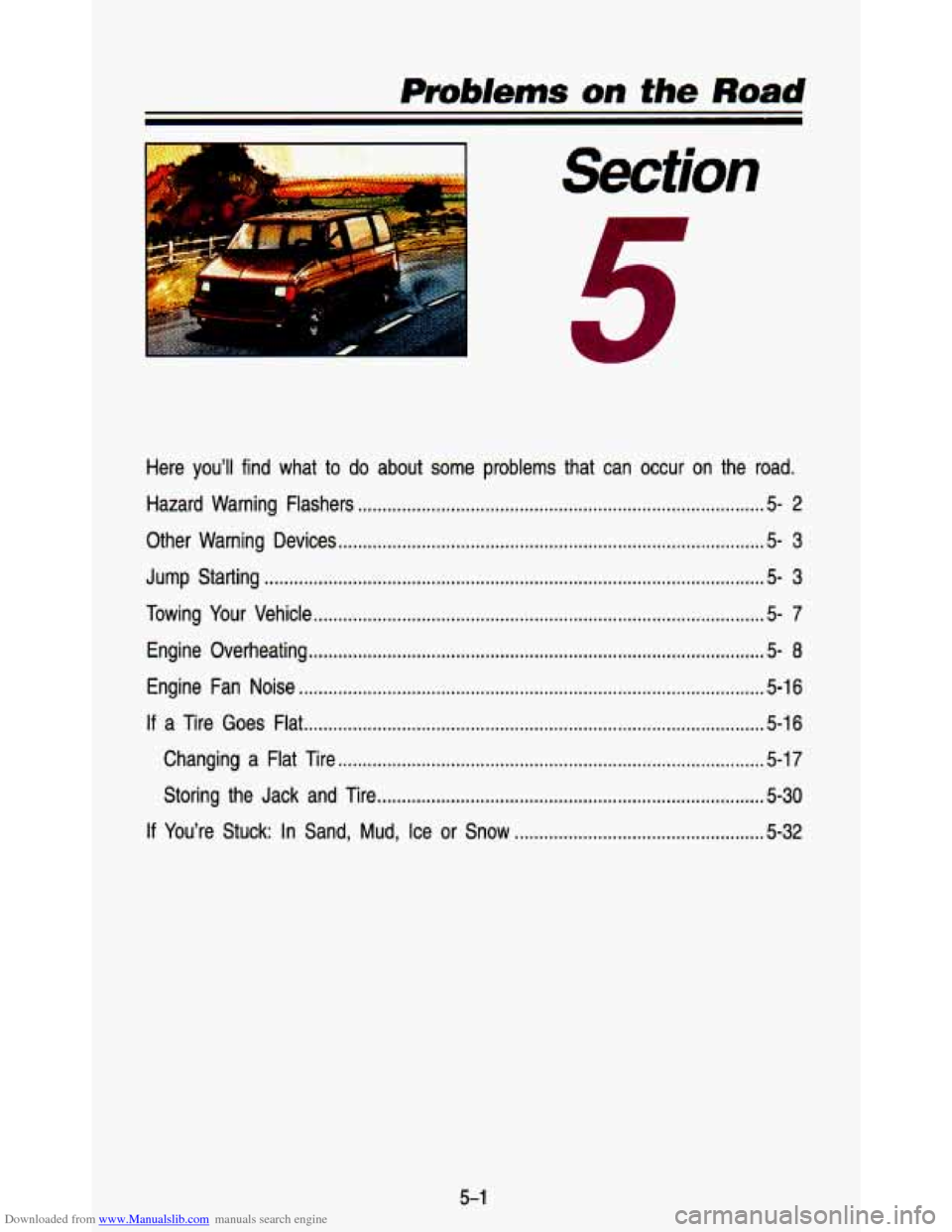
Downloaded from www.Manualslib.com manuals search engine I m Section
Here you’ll find what to do about some problems that can occur on the road .
Hazard Warning Flashers ........................................................................\
........... 5-2
Other Warning Devices ........................................................................\
............... 5-3
Jump Starting ........................................................................\
.............................. 5-3
Towing Your Vehicle ........................................................................\
.................... 5-7
Engine Overheating ........................................................................\
..................... 5-8
Engine Fan Noise ........................................................................\
....................... 5.16
a Tire Goes Flat ........................................................................\
...................... 5-16
Changing a Flat Tire ........................................................................\
............... 5-17
Storing the Jack and Tire ........................................................................\
....... 5-30
You’re Stuck: In Sand, Mud, Ice or Snow ................................................... 5-32
5-1
Page 211 of 345
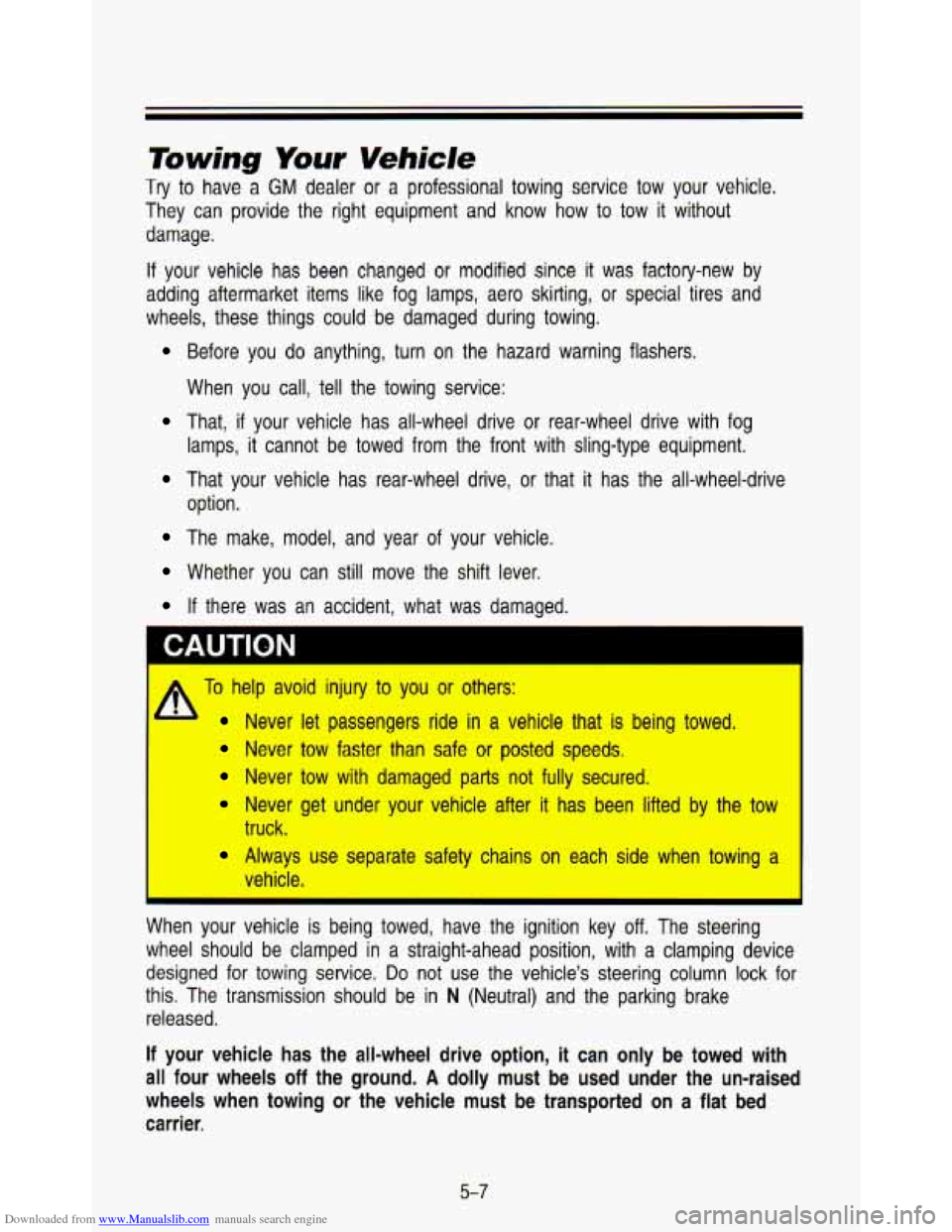
Downloaded from www.Manualslib.com manuals search engine Towing Your Vehicle
Try to have a GM dealer or a professional towing service tow your vehicle.
They can provide the right equipment and know how to tow it without
damage.
If your vehicle has been changed or modified since it was factory-new by
adding aftermarket items like fog lamps, aero skirting, or special tires and
wheels, these things could be damaged during towing.
Before you do anything, turn on the hazard warning flashers.
When you call, tell the towing service:
That, if your vehicle has all-wheel drive or rear-wheel drive with fog
lamps, it cannot be towed from the front with sling-type equipment.
That your vehicle has rear-wheel drive, or that it has the all-wheel-drive
option.
The make, model, and year of your vehicle.
Whether you can still move the shift lever.
If there was an accident, what was damaged.
* To help avoid injury to you or others:
I
Never let passengers ride in a vehicle that is being towed.
Never tow faster than safe or posted speeds.
Never tow with damaged parts not fully secured.
Never get under your vehicle after it has been lifted by the tow
Always use separate safety chains on each side when towing a
truck.
I vehicle.
When your vehicle is being towed, have the ignition key
off. The steering
wheel should be clamped in a straight-ahead position, with a clamping device
designed
for towing service. Do not use the vehicle’s steering column lock for
this. The transmission should be in
N (Neutral) and the parking brake
released.
If your vehicle has the all-wheel drive option, it can only be towed with
all four wheels
off the ground. A dolly must be used under the un-raised
wheels when towing or the vehicle must be transported
on a flat bed
carrier.
5-7
Page 220 of 345
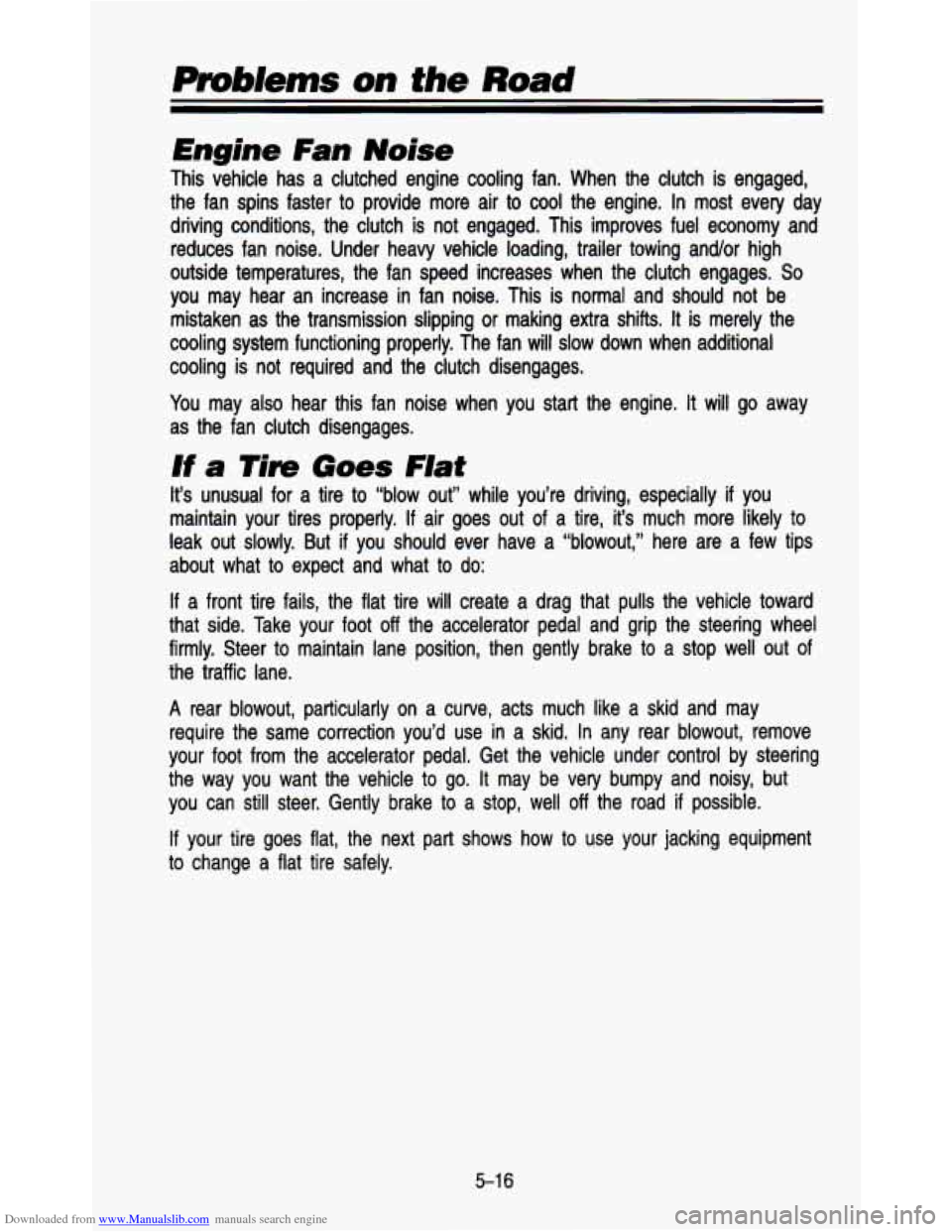
Downloaded from www.Manualslib.com manuals search engine Pmblems on the Road
Engine Fan Noise
This vehicle has a clutched engine cooling fan. When the clutc\
h is engaged,
the fan spins faster
to provide more air to cool the engine. In most every day
driving conditions, the clutch is not engaged. This improves fu\
el economy and
reduces fan noise. Under heavy vehicle loading, trailer towing \
andlor high
outside temperatures, the fan speed increases when the clutch e\
ngages.
So
you may hear an increase in fan noise. This is normal and should not be
mistaken as the transmission slipping
or making extra shifts. It is merely the
cooling system functioning properly. The fan will slow down whe\
n additional
cooling is not required and the clutch disengages.
You may also hear this fan noise when you start the engine.
It will go away
as the fan clutch disengages.
If a Tim Goes Flat
It’s unusual for a tire to “blow out” while you’re driving, especially if you
maintain your tires properly.
If air goes out of a tire, it’s much more likely to
leak out slowly. But
if you should ever have a “blowout,” here are a few tips
about what to expect and what
to do:
If a front tire fails, the flat tire will create a drag that pulls the vehicle toward
that side. Take your foot
off the accelerator pedal and grip the steering wheel
firmly. Steer
to maintain lane position, then gently brake to a stop well out of
the traffic lane.
A rear blowout, particularly on a curve, acts much like a skid \
and may
require the same correction you’d use in a skid. In any rear blowout, remove
your foot from the accelerator pedal. Get the vehicle under co\
ntrol by steering
the way you want the vehicle
to go. It may be very bumpy and noisy, but
you can still steer. Gently brake
to a stop, well off the road if possible.
If your tire goes flat, the next part shows how to use your jacking equipment
to change a flat tire safely.
5-1 6
Page 221 of 345
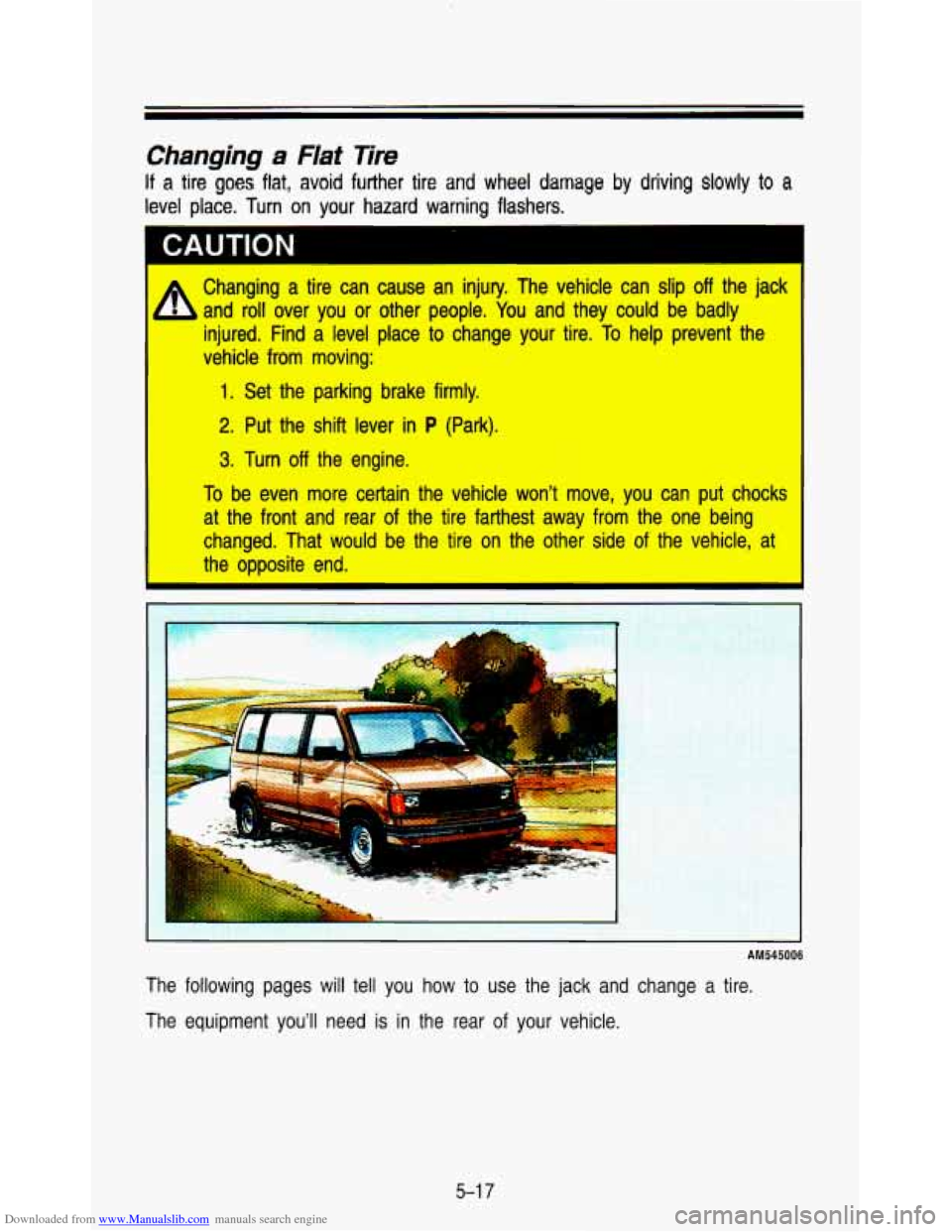
Downloaded from www.Manualslib.com manuals search engine Changing a Flat Tire
If a tire goes flat, avoid further tire and wheel damage by driving slowly to a
level place. Turn on your hazard warning flashers.
I CAUTION
4
Changing a tire can cause an injury. The vehicle can slip off the jack
and
roll over you or other people. You and they could be badly
injured. Find a level place
to change your tire. To help prevent the
vehicle from moving:
1. Set the parking brake firmly.
2. Put the shift lever in P (Park).
3. Turn off the engine.
To be even more certain the vehicle won’t move, you can put chocks
at the front and rear of the tire farthest away
from the one being
changed. That would be the tire on the other side
of the vehicle, at
the opposite end.
I
I
AM545006
The following pages will tell you how to use the jack and change a tire.
The equipment you’ll need
is in the rear of your vehicle.
5-1 7
Page 224 of 345

Downloaded from www.Manualslib.com manuals search engine Prob/ems on the Road
K3533
The ratchet has an UP side and a DOWN side.
PO41 8
Attach the ratchet, with the DOWN side facing you, to the extension. The
extension has a socket end and a flat (screwdriver shaped) end. Put the flat
end of the extension on an angle through the hole in the rear door \
frame,
above the bumper. Be sure the flat end connects into the hoist shaft.
Turn the ratchet counterclockwise to lower the spare tire to t\
he ground. Keep
turning the ratchet until the spare tire can be pulled out from under the
vehicle.
5-20